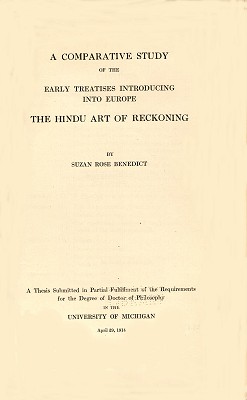Suzan Rose Benedict
A Comparative Study of the Early Treatises Introducing into Europe the Hindu Art of Reckoning
University of Michigan, 1914

Introduction
In any study of the development of human thought, emphasis is justly laid upon the periods of great discovery, while the centuries in which, through slow evolution, were built the foundations for those discoveries are passed over with a word. Such a period in the development of mathematics we find in the years of transition from the dark ages to the renaissance, when the introduction into Europe of a convenient numerical symbolism furnished one of the most useful tools for the great works of a Descartes or a Newton.
Many manuscripts written during this period are among the treasures of the European libraries, and a bibliography of such works was begun by A. A. Bjornbo of Copenhagen, but his early death prevented its completion, and the results of his research are still unpublished. Other historians have found and studied individual treatises, but no careful investigation of the period as a whole has been made, and the best of our histories are unsatisfactory in its treatment.
If however, instead of consulting these works we turn our attention to the monographs which have appeared since the middle of the last century...we find that much has been done to increase the knowledge of this period. Through the efforts of men like Boncompagni, Curtze and Enestrom many Latin manuscripts have been discovered and transcribed, and works in the Sanscrit, Arabic and Hebrew have been translated into European languages by such scholars as Scolebrooke, Woepcke, Silberberg and Steinschneider; so that with increasing quantity of material available, there will come in the near future a much more complete knowledge of the mathematics of the middle ages.
It has been with the hope of making a contribution to such knowledge that the research, the results of which are embodied in this paper, has been carried on. As a first step it seemed advisable to find the arithmetics of this period which have been published, and to make a bibliography which may perhaps save valuable time for some later study. Accordingly, a systematic search has been made, and all the treatises found, unless dealing exclusively with abacus reckoning, have been noted. There is included in this bibliography, where it has been possible to find such information, the name and date of the treatise, a few words concerning the author, the library where the manuscript may be found and the journal or monograph in which it is published. There is added to this, a brief account of the contents, the approximate length, and in the case of the Latin works, the works of the beginning and end.
These arithmetics have been read throughout, but since many of them are long and treat of a variety of subjects, it has been found necessary to limit the scope of this paper to a discussion of the fundamental operations upon integers. Accordingly, the various methods of performing the operations are described, and a comparison of them is made in order to ascertain to what extent the Latin works were derived from Arabic sources and which of the algorisms were most influential in determining the character of later treatises.
Conclusion
To summarize briefly the results of this research, we may say that the elements of arithmetical calculations as taught today derived their definitions from the Greeks and from Boethius, and their methods from the Hindus; that the Arabic treatises have received too little appreciation, and were equaled only by those of the Hebrews of the same period; that the influence of the abacus, showing itself in expression and method is apparent in the Latin works, even when concerned wholly with the new reckoning; that the Liber algorismi de practica arismetrice, based upon the arithmetic of Al-Khowzrizmi, and other Arabic treatises was known and used by most of the later writers; and that up to the time of printing the Carmen de Algorismo of Alexander de Villa Dei, and the Algorismus vulgaris of Sacrobosco were the most widely read of all the Latin works.
Contents
- Introduction
- A Descriptive Bibliography of Sources
- The Fundamental Operators
- Numeration
- Addition
- Subtraction
- Mediation and Duplation
- Multiplication
- Division
- Summary
List of Treatises Described
- Ganitád' hyáya of Brahmagupta
- Algoritmi de numero Indorum
- Ganita-sára-sangrapha of Mahaviracarya
- The arithmetic of Kuschyar ibn Labban
- Trisatika of Sridharacarya
- The arithmetic of Al-Nawawi
- The arithmetic of Avicenna
- Al Kâfî fîl Hisâb of Al-Karkhi
- The arithmetic of Al-Hassar
- Lílávatí of Bháskara
- Liber algorismi de practica arismetrice
- A 12th century algorism
- The arithmetic of Raoul de Laon
- Sefer Ha-Mispar of Rabbi ben Esra
- Opus numerorum, and Demonstratio Jordani
- Liber abaci of Leonard of Pisa
- Carmen de algorismo of Alexander de Villa Dei
- Algorismus vulgaris of John of Sacrobosco
- Salem Codex
- Talkhys of Al-Banna
- Prologue N. Ocreatus in Helceph ad Adelardum Batensem Magistrum suum
- Algorithmus demonstratus of Gernardus
- A French algorism of the 13th century
- A 13th century algorism
- Commentum magistri Petri Philomeni de Dacia
- Sefer Maassei Chascheb of Lewi ben Gerson
- An Icelandic algorism
- The arithmetic of Planudes
- Quadripartitum numerorum of Jean de Meurs
- An English algorism of the 14th century
- A treatise on numeration of algorism
- Algorismus prosaycus magistri Christani
- Algorismus de integris of Prosdocimo de Beldamandi
- The algorism of John Killingworth
- A 15th century algorism
- A German algorism
- The arithmetic of Al-Kalcadi
- Elementa artihmetica algorithmus de numeris auctore Georgio Peurbachia
